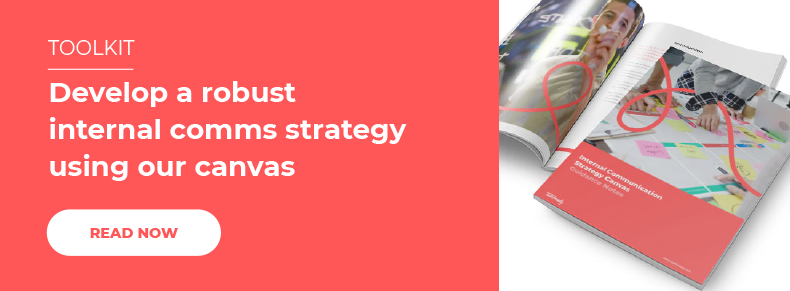It’s the holy grail everyone is searching for. The simple way to ensure your employees are fully informed and engaged. Because engaged employees are the heart and soul of your organisation. They are filled with a purpose and enthusiasm that money just can’t buy. And they will be more motivated in their roles, leading to a decrease in staff turnover and an increase in productivity. To put it simply, get your internal communications right and you have the golden ticket for success.
In this guide, we take a look the importance of employee communications and how business leaders can utilise its power to transform their business efforts. These 10 need-to-know essentials will help you instantly improve internal communication within your organisation. Put these suggestions in place, and you’ll see how an effective employee communication model will take your business to the next level.
#1 Employee communication is not just about delivering information
Let’s take a look at the employee communication definition. Communication itself is defined as the process of exchanging information and understanding from one person to another. It is the transmission of facts, ideas, opinions and values. Employee communication then, as defined in the business sense, is the exchange of information and understanding with and among employees within the work environment. The essential difference is that employee communications have a desired set of commercial results and outcomes, as defined by your internal communication plan.
It is important to note that effective employee communication isn’t just about the delivery of information. It is the ‘exchange’ of information. Rather than a one-way information stream, your employee communications channels should always operate as a two-way dialogue between staff and leaders.
#2 Strong employee communication is vital for success
Informed and engaged employees are your most valuable asset. They’re dedicated, productive, loyal and committed to your success. They’re connected to company news, they’re informed about industry developments, they’re involved with other departments and they’re united in their belief in the organisation. This is what your employee communication program should be focused on; creating a fully engaged and motivated workforce. The benefits of good internal communication can never be overstated:
- Productivity - A report by Business2Community, revealed that organisations with high employee engagement outperform those with low engagement by 202%. Once work becomes more than simply performing a role, you’ll find employees start adding value, thinking on their feet, and breaking targets.
- Understanding– Employees who understand their role and their value in the company will work with you to fulfil your overall strategy. Knowledge is power. Employees who feel like insiders, with almost as much knowledge as the top decision makers, are much more invested in the organisation as whole than just their role.
- Retention– Employees who feel personally connected to their company are less likely to be open to new opportunities. Solid employee communications systems will ensure employees at every level of the organisation feel ‘in the know’ and part of the bigger picture, and these employees are going nowhere.
- Flexibility– Communicating change in the workplace is not an easy task. Effective employee communication will ensure staff are ready to adapt. This is particularly relevant to communication in a crisis, helping workers to feel part of the change, not subject to it.
- Advocacy– Employees who operate as brand ambassadors are hugely influential and help to project a positive external image. When you have an army of employees who can’t resist talking up their company, you’ll have a team of influencers that have more power than any marketing campaign. It’s one of the key internal communication best practices.
#3 Employee communication needs to come from the top
The impact of leadership on employee engagement is significant. In fact, a recent survey from Unit 4 revealed that the CEO has a major influence on the ultimate success or failure of the organisation. Their research showed that it is the leader who guides the company’s ethos, culture and direction.
“Our research clearly shows the CEO is the figurehead. People still look to the CEO to set the direction of the company. This is where CEOs can stamp their mark.”
Senior management have a big responsibility on their hands. They are answerable for setting the tone of the whole organisation. This can be a good or bad thing, depending on your approach. A friendly, charismatic leader will create a very different working atmosphere than an unsociable and detached one. It is senior management’s role to convey the company values and beliefs in a positive light and this can be best managed through a well-defined employee communication process.
#4 Employee communication can be used to level the hierarchy
Just because your employee communications are originating from the top, it doesn’t mean that employees shouldn’t be given the opportunity to speak out too. Forget the old model of business where the leader issues orders from his ivory tower. Times have changed and business is now much more of a collective venture. The role of internal communication is to listen as much as it is to inform.
The top-down management strategy is no longer appropriate and needs to be replaced by involving a large proportion of your workforce in your decision-making. Consider implementing effective internal communication tools to allow feedback to flow. An internal communications app offers in-built feedback channels to encourage that all-important two-way communication. Give employees a chance to express their ideas and opinions and you’ll instantly see positive results.
#5 Only leaders can really empower the workforce
Your employees have a lot to offer your organisation. If you give them the chance. When it’s only senior management driving productivity and innovation, you’re not only missing out on a huge source of inspiration, you’re also failing to engage with your staff. It is only the leaders who can take this decision to empower their workers, so therefore it is the leaders who need to drive this initiative to tap into the power of their workforce. This is where good employee communication comes into play.
The right internal communications software will assist you with installing a company ethos of progress and improvement. Innovation modules allow employees to put forward ideas and suggestions that address business challenges. This employee communication portal will allow you to rate ideas, post challenges and capture suggestions. It will also help you manage the ideas workflow through to implementation. Seeing plans through to completion is an essential part of the internal communication process.
#6 It’s your job to ensure every single employee is connected
One of the common internal communication mistakes is failing to identify all subsets of your workforce. Quite often, there are large numbers of employees who somehow slip through the net and fail to be reached by your employee communications. Without that regular flow of information and interaction, they become disconnected and disengaged.
It’s easy to assume those hard-to-reach employees are remote workers, located away from the central hub of the office. However, this isn’t always the case. What makes an employee disconnected isn’t based on location or role. It’s whether they’re connected to the employee communication tools you’re using. If your employees are not hooked up to a collective two-way channel, you can almost guarantee they won’t be receiving your communications efforts.
If you want to ensure your messages reach every single employee, you need extremely robust employee communication channels in place. Give every worker access to an employee app and you’re heading in the right direction. By providing an app that links to internal communications software, your staff can use their own smart devices to access company communications. Simply by allowing employees to use their own devices, and choose their own channels, you’ll be cutting through many levels of resistance.
#7 Your communications need to connect on a personal level
Think beyond news updates and management reports. Yes, these are important. But if you want to really engage your workers, you need to grab, and hold, their attention. The bottom line is, your employee communications have to be interesting. You need to create content that jumps out and connects with staff on a personal level. Here are a few internal communication ideas to add variety and interest to your output:
- Knowledge– Make it a priority to share knowledge across the organisation. Whether you include Q&As with company experts or how-to-guides about common work issues, you’ll find performance is boosted as result.
- Industry News– Remember to include information about the industry as whole, not just the company. By including industry updates in your employee communications you’ll help staff realise they are part of bigger picture.
- Feedback– Employee communication channels should always be a two-way street. Include internal communication surveys, opinion polls and opportunities to pitch ideas and suggestions. Give your employees a voice.
- Achievements– Recognising success will have an immediate impact on engagement levels. Whether it’s a single employee or a whole team, if something has been done well, make sure the whole company hears about it.
- Fun Stuff– Bring a little fun into the picture. As long as you’re careful not to embarrass people, sharing amusing office moments, or including light-hearted ‘day in the life’ stories can break down barriers and build friendships. This is a key element of effective internal communication.
#8 A consistent pace of delivery is the key to engagement
A vital element of any employee communication plan is the scheduling of messages. Your aim should be to deliver a consistent pace of communications, maintaining regular contact with all employees at all times. Too often, internal communications can become a stop-start affair, with flurries of activity followed by times of silence. This will have the unfortunate effect of causing previously high engagement levels to drop, as employees start to feel forgotten and side-lined. Employee engagement and communication are very closely linked. This is the key to effective communication in the workplace.
Assess the year ahead and note which key communications and events will be happening when. Then add in your regular messaging; company news, industry news, new hires, how-to guides, employee of the month etc. By adding all these elements into a project tracker, you will then create a birds-eye view of your upcoming communication schedule.
With an internal communications app, you have the tools at your disposal to pre-schedule regular communications. News Modules allow you to schedule daily updates, Event Modules send out notifications of upcoming events, and Pulse Modules conduct analysis of engagement levels with routine check-ups. This constant stream of information will contribute to a more informed, engaged workforce.
#9 Communication channels have to suit your audience
Put simply, you need to select the right tool for the job at hand. How effectively a message is communicated is just as important as the message itself. And the key to effective employee communication is choosing the right channel in the first place. You need to select internal communication channels that best fit both your objective and your target audience.
In their focus on the content of their internal communication, many companies fail to consider the channels they are using to deliver it. As such, they are often relying on tools that fail to deliver.
Newsletters, intranets, email, meetings, document silos – all these methods have value, but individually they fail to offer the full breadth of communication needed for full engagement.
For example, intranets fail to engage employees to their full potential due to poor traffic and a failure to keep them updated. Newsletters lack the essential mobile element. And emails and meetings are one-way channels, that do not promote discussion and engagement. Get your employee communication tools right and you’ll find engagement takes an upward trajectory.
You may want to consider moving your communications to an internal communications app These act like a super-channel for employee communications. They offer a range of tools and channels and all your employees need to access it is a single device. This makes it possible to keep everyone up to date at regular intervals, regardless of location or computer access. As such, they offer a highly effective, low-cost way to communicate across an organisation.
#10 The true importance lies in the outcome of your efforts
Never forget, your focus should always be on the result of the activity, not the activity itself. One of the common internal communication mistakes is to fail to measure the success of the employee communications you are sending out.
The measure of success will differ according to each individual business and the challenges you face. For some organisations, the main aim may be to retain staff. Others will be looking to reduce costs, increase profitability or boost brand awareness through employee influencers. Whatever your business goals, the key is to identify your priorities and keep on top of measuring internal communications.
An employee communication app will allow you to continually evaluate the success of your communications and adjust your strategy accordingly. Dashboards allow you to understand your audience in more depth, providing information on how teams and divisions interact. Built-in reporting allows you to dig deeper into the details, giving a detailed analysis of module, post and employee performance. You can even monitor your eNPS (employee Net Promoter Score) to keep track of loyalty levels. In essence, an employee app takes away all the guesswork.
The final word
When it comes to effective employee engagement and communication, it’s clear that you need a robust internal communication strategy in place, along with flexible employee communication tools that really resonate with your staff. The key elements to remember?
- Reach- Make sure your messages connect with every single employee, even the hard-to-reach ones.
- Engage – Make sure staff get involved with two-way channels to encourage feedback and participation.
- Measure– Make sure you are continually evaluating the efficacy of your employee communication.
Topics:
Internal Communications







.jpg)
.jpg)